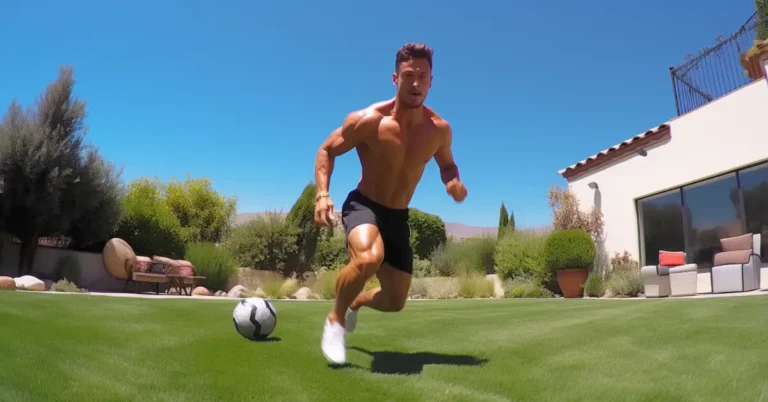📦 FREE Shipping
10 Cardiovascular Endurance Workouts 2024 (Healthier Heart)

Often simply referred to as cardio, cardiovascular endurance workouts are a cornerstone of physical fitness. It reflects my heart and lungs’ ability to supply my working muscles with blood and oxygen during sustained physical activity. Whether I choose to do an endurance swim, cycle, or run, these activities all serve to bolster my body’s ability to undertake and sustain aerobic exercises.
10 Key Cardiovascular Endurance Workouts
Whether I’m pressed for time at home or geared up for the gym, there are specific cardiovascular endurance workouts that are fantastic for boosting my fitness. Here, I’ll share my go-to exercises that fit seamlessly into any routine and are designed to get my heart rate up and my blood pumping.
5 Cardiovascular Workouts You Can Do At Home
- Running in Place: This simple yet effective workout gets my heart rate up without any equipment. By keeping a consistent pace, I aim to maintain the motion for at least 5 minutes before taking a short rest.
- Stair Climb: If I have access to a staircase, repeated climbs provide a challenging workout for my heart and leg muscles. I make sure to go at a pace that keeps me breathing heavily but still allows me to talk.
- Jumping Jacks: A classic calisthenic exercise, doing jumping jacks for intervals of 2 to 3 minutes can help improve my cardiovascular endurance.
- Burpees: Incorporating a squat, jump, and push-up, burpees are an all-in-one workout. I perform them in quick succession to challenge my cardiovascular system.
- High-Intensity Interval Training (HIIT): I set up a circuit of bodyweight exercises like push-ups, squats, and sit-ups, performing each at high intensity for about 30 seconds with a 10-second rest in between.

5 Cardiovascular Workouts You Can Do In The Gym
- Treadmill Running: At the gym, I utilize the treadmill to simulate various running conditions. Adjusting the incline can mimic uphill running and intensify my workout.
- Cycling: Stationary bikes are perfect for a low-impact yet challenging cardiovascular workout. I often include cycling at different intensity levels to mix things up.
- Swimming: If a pool is available, I go for swim sessions that not only work my cardiovascular system but also offer full-body resistance training.
- Rowing Machine: This provides a fantastic cardiovascular workout that engages the legs, core, and arms, enhancing both my strength and endurance.
- Elliptical Trainer: I find the elliptical to be a joint-friendly alternative to jogging, allowing me to vary the intensity and work different muscle groups.
Free PDF Workout Plans For You.
Are you in need of motivation? Here are some powerful workout plans with PDF downloads you can choose from:
— Pamela Reif Workout Plan
— 30 Day Peloton Workout Plan
— Beginner Calisthenics Workout Plan
— Andy Galpin Workout Plan
Setting Your Cardio Goals
My cardio goals are personal milestones that guide my cardiovascular endurance workouts and help me track my progress. Here’s how I define and achieve them:
- Define Clear Objectives: Whether it’s to walk 30 minutes a day without getting winded or to complete a local 5K race, my goals are specific and measurable.
- Plan for Gradual Progress: I know that building endurance doesn’t happen overnight, so I set incremental targets that push me a little further each week.
- Track My Achievements: I maintain a workout log to celebrate my successes and understand my body’s response to various exercises.
By focusing on my beginner status and respecting my body’s current fitness level, I set a firm foundation for my cardiovascular workouts.
Measuring and Tracking Progress
As I dive into the world of cardiovascular endurance workouts, I find it’s crucial to monitor my progress. There are some reliable methods I use to ensure that my fitness level is improving, and they involve checking my heart rate, tracking specific exercise metrics, and incorporating CrossFit training.
Monitoring Heart Rate
Resting Heart Rate: Each night, I wear my fitness watch, which measures my resting heart rate. I look for a consistent decrease over time, which indicates an improvement in my cardiovascular fitness.
Active Heart Rate: During workouts, I use a heart rate monitor to track how intensely I’m exercising. I aim to maintain my heart rate within a target range for at least 150 minutes each week, as per the standard recommendations for aerobic exercises.

Endurance Exercise Metrics
Tracking time, distance, and intensity is essential to my fitness regimen. Here are some specific metrics I keep an eye on during cardiovascular endurance workouts:
- Duration: I log the amount of time I spend on each workout, aiming to gradually increase it as my endurance improves.
- Distance: If I’m running or cycling, I note the distance covered. Seeing this number rise encourages me that I’m progressing.
- Frequency: I make sure to exercise consistently throughout the week, with ideally three to five workouts to balance rest and exertion.
Cross-training for Comprehensive Fitness
To prevent plateaus and overuse injuries, I integrate cross-training into my routine. This might involve switching between:
- Aerobic exercises: such as swimming, cycling, or using the elliptical.
- Strength training: to enhance overall muscular endurance and support my cardiovascular training.
Julian
SEO at PlanetGains
By mixing these activities, I work on different muscle groups and give myself a well-rounded fitness experience that contributes to my cardiovascular health.
Benefits of Cardiovascular Fitness
As I reflect on cardiovascular fitness, I think about how engaging in regular workouts strengthens not only the heart and lungs but also offers a broad range of benefits for both physical health and mental well-being.
Physical Health Advantages
- Heart Health: My heart muscle gets stronger through consistent aerobic exercise, leading to improved circulation and a lower risk of heart disease.
- Cholesterol Management: Engaging in such activities helps in managing cholesterol levels by increasing good HDL cholesterol while decreasing bad LDL cholesterol.
- Blood Pressure Regulation: Regular cardiovascular exercise contributes to maintaining or reducing blood pressure, thereby lessening the strain on my heart and arteries.
- Blood Sugar Control: It aids in managing blood sugar levels, which is especially beneficial for preventing or managing type 2 diabetes.
- Disease Prevention: By enhancing heart function and blood flow, it can also lower my risk of developing other diseases.
- Weight Control: I find it effective in burning calories and maintaining a healthy weight.

Mental Health and Wellness
- Mood Improvement: Cardiovascular exercises like running or swimming release endorphins, which are my body’s natural mood lifters.
- Stress Relief: Physical activity becomes an outlet for stress, helping me feel more relaxed.
- Better Sleep Patterns: Regular workouts contribute to better sleep quality by helping me fall asleep faster and deepening my sleep.
By integrating cardiovascular endurance workouts into my routine, I ensure a healthier heart, better mood, and improved overall health.
My experience with Cardiovascular Endurance Workouts
In my journey to boost my cardiovascular endurance, running has become a cornerstone. Initially, every step was a challenge, but with consistency, I’ve seen a dramatic improvement in my stamina. On alternate days, I lace up my sneakers for a comfortable 5K, focusing on keeping a steady pace rather than speed.
Swimming has also been an incredible workout for my heart and lungs. The rhythmic strokes and breath control during my twice-a-week pool sessions are meditative. I’ve noticed how it aids in recovery, especially after running days, and complements my efforts to build endurance.

Cycling offers another enjoyable and effective way to work on my endurance. Whether on a stationary bike or taking scenic routes outdoors, I appreciate the low impact yet high-reward nature of this exercise. I aim for longer rides at moderate intensity at least once a week to push my endurance limits.
My personal blend of endurance activities has not only improved my physical fitness but also my mental well-being. The sense of achievement with each passing week keeps me motivated to stay the course and embrace these workouts as part of my lifestyle.
Frequently asked questions about Cardiovascular Endurance Workouts
What is the best workout for cardiovascular endurance?
When talking about the best cardiovascular endurance workouts, it truly depends on individual fitness levels and preferences. High-Intensity Interval Training (HIIT) is considered highly effective because it involves short bursts of intense exercise followed by recovery periods, which can massively improve endurance.
What are the 5 exercises of cardiovascular fitness?
The top five cardiovascular endurance workouts include Jogging or Running, Swimming, Cycling, Rowing, and Jumping Rope.
What cardio burns most fat?
Cardio exercises that burn the most fat tend to be high in intensity. HIIT workouts, due to their vigorous nature, can lead to significant fat loss over time. Other effective exercises include sprinting, kickboxing, and indoor cycling, which have all been shown to have a high caloric burn.
What exercise measures cardiovascular endurance?
To measure fitness in cardiovascular endurance workouts, professionals often use tests such as: The VO2 max test, which estimates the maximum amount of oxygen your body can use. The Cooper test, involving a timed run for distance within 12 minutes.
Is walking cardiovascular endurance?
Yes, walking can be a form of cardiovascular endurance workouts, especially when done briskly for extended periods. While it’s less intense than running, it’s still effective for improving heart health and can be a great option for beginners or those looking for a low-impact exercise.
Did you like to learn about Cardiovascular Endurance Workouts? Let me know in the comments. Make sure to also read about Muscular Endurance Workouts and try the 30 Days Peleton Workout Plan for free.





